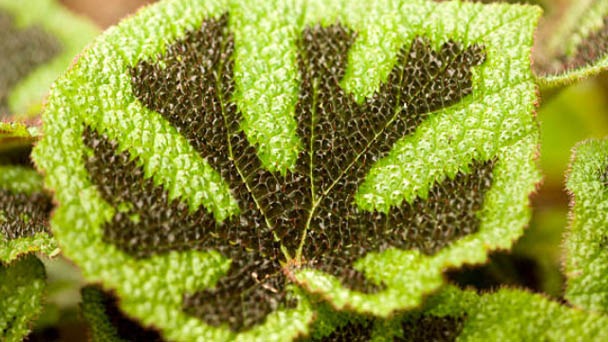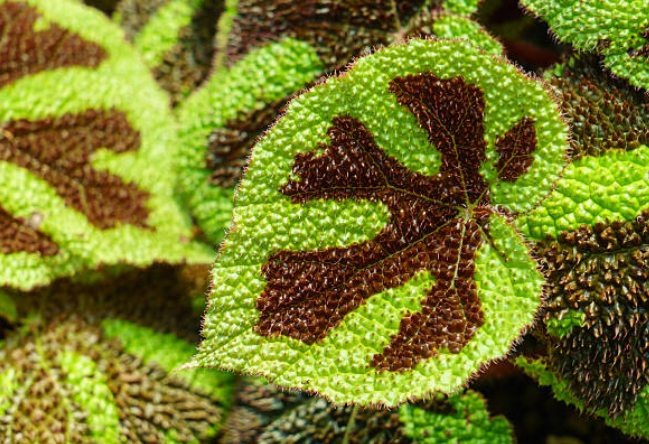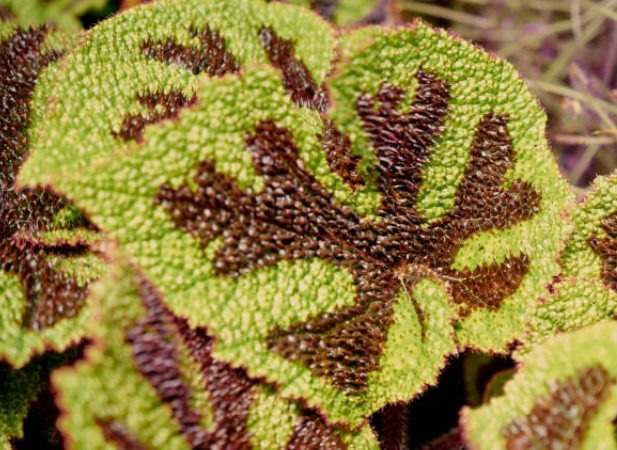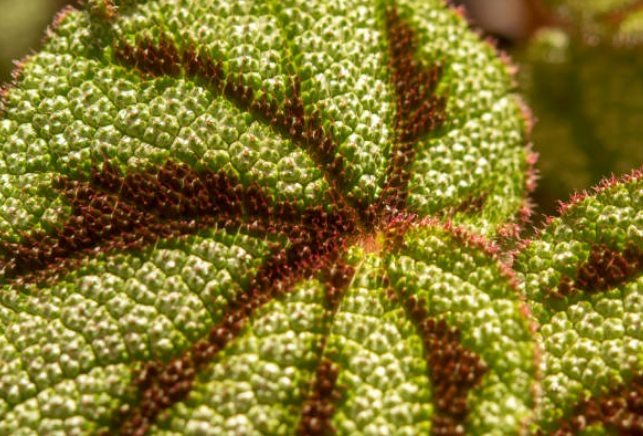Iron-Cross Begonia (Begonia Masoniana) Caring Guide 2023
Written by Ivy
Jan 03 2023

One of the most intriguing and distinctive-looking plants you can get is the iron cross begonia. Its name is derived from the center of its fuzzy, bright green leaves, which are marked by a reddish brown cross pattern.
This plant is a species of the Begoniaceae family that is indigenous to southern China, northern Vietnam, and India. It is also known by the name Begonia masoniana. In environments with high humidity and warm temperatures, this plant can thrive all year long. One of the many plants to receive the Royal Horticultural Society's Award for Garden Merit is the iron cross begonia.
Iron-Cross Begonia (Begonia Masoniana) Description

The Begoniaceae family, which includes begonias, includes iron cross begonia. The family of flowering plants known as Begoniaceae, with about 1500 different species and hundreds of hybrids, is named in honor of Michael Begon (1638–1710), the governor of French Canada. The height of mature begonia plants varies from a few inches to over 12 inches, and there is a wide range in the colors and sizes of the flowers and the foliage.
A delicate, herbaceous perennial with a native range of China and Vietnam, the iron cross begonia is typically grown as an ornamental houseplant. Instead of its seasonal greenish/white floral display, which it produces from a rhizome, this plant is prized for its distinctive foliage. The leaves' dark chocolate centers have markings that resemble the Iron Cross that was applied to shields during the Crusades. The species name honors L in Latin. This plant was brought back to England from Singapore in 1952 by English plant collector Maurice Mason, who gave it the common name "iron cross."
The plant can withstand temperatures as low as 55 degrees Fahrenheit outdoors but prefers low 70s. It is hardy to USDA zones 11 and 12. When grown as a houseplant, place it in bright but filtered or indirect light (for example, a southern, eastern, or western window), use moisture-retentive potting soil, and maintain even moistness throughout the plant's growth stages. Reduce the amount of water you apply when active growth slows down. Wait until the soil's surface is almost dry before adding more water.. Despite the fact that this plant prefers high humidity, which is enhanced by setting the pot on a gravel tray filled with water, it must not be overwatered. Cuttings of the stem or leaves can be used to multiply iron cross begonia.
Iron Cross Begonia Features
- A rhizomatous perennial plant with an evergreen stem that can reach a height of 1 foot (30 cm), the Iron Cross Begonia is a native of Asia's tropics.
- The large, vivid green, pebbly, oval leaves on these plants, each with a striking burgundy cross in the center, make them stand out.
- In addition to their stunning foliage, these plants produce pink and white flowers in the summer.
- This plant thrives in the shade and can be grown inside under fluorescent artificial lighting, making it a wonderful houseplant. It looks best when combined with other brightly colored plants that prefer shade.
- Usually sold as a potted plant, the Iron Cross Begonia. Make sure there is adequate protection from wind and frost when planting Iron Cross Begonias outdoors. To help it grow and make it harder to survive the winter, Iron Cross Begonias should be planted outdoors during warm seasons.
How to Care for Iron Cross Begonia
Watering
When watering your Iron Cross Begonia, you must exercise extreme caution. These plants will perish from overwatering because of their rhizomatous roots, which store water. It is best to keep the foliage dry, never mist it, and only water the plant at its soil because of their large leaves' propensity for mildew and fungus growth that can result in crown rot.
Only use room temperature water when watering the plant as using cold water could be detrimental. Depending on the stage of a plant's growth, different amounts of water are required. Iron Cross Begonias require consistently moist soil during their active growing stage in order to maintain their growth.
To keep the soil moist without letting it become soggy from excess water, water the soil about an inch every week. In order to keep the soil evenly moist, the mulch will also be helpful. Since the soil requires less water as growth slows, you can wait longer between waterings.
Being a native of the tropical regions of Southeast Asia, the Iron Cross Begonia also prefers humidity to water. It is best to keep the humidity in the air at 50% or higher.
You can use a humidifier to increase the humidity level above 50% if the air inside your home is dry. Never succumb to the temptation to add more water to the soil if your plant begins to shrivel up or collapse. Instead, keep the plant at room temperature for 6 to 8 weeks while covering it with plastic or using a glass cloche.
This will contribute to making the environment more humid for the plant. When doing this, it's also a good idea to keep a close eye on the plants because an increase in humidity might also encourage fungal growth on its foliage.
Soil
If you adhere to a few of the Iron Cross Begonia's growth requirements, growing one is a piece of cake. These plants prefer an acidic soil with a pH between 6.1 and 6.5 that is rich in organic matter.
They can, however, also thrive in neutral soil with a pH range of 6.6 to 7.5. However, you can also make your own organically rich soil by adding a lot of peat moss and leaf mold to the soil you already have on hand. African violet potting mixes are ideal for this.
A good drainage system and soil porosity are also requirements. The drainage of the soil mixture can be improved by adding perlite or vermiculite. You can choose to place the Iron Cross on a raised bed if these are not readily available. A water-soluble, high-nitrogen fertilizer with a 10-10-5 ratio that has been diluted to half-strength should be applied to the soil once every month. To prevent fertilizer burn, it is best to fertilize when the soil is already moist.
Sunlight
The Iron Cross Begonia must spend the majority of the day in bright, indirect sunlight when it comes to light conditions. These should not be exposed to direct sunlight as they will dry out and die. It is best to place these plants near windows that face south, east, or west indoors.
Begonias can be grown successfully even under artificial lighting, which is one of their many advantages. These plants can be exposed to fluorescent grow lights for approximately 14 hours per day, which is equivalent to 8 hours of daylight.
Indoors the best place for your iron cross begonia is in a spot with bright, indirect light, such as an east-facing or north-facing window.
The drawings made on the leaves may become faded if they are exposed to too much direct sunlight. Use something to block the light, like a sheer curtain.
Temperature
Since they are tropical plants, Iron Cross Begonias thrive in temperatures between 65 and 75 degrees Fahrenheit (18 and 24 degrees Celsius). In order to avoid withering and death, these plants must not be exposed to temperatures below 55°F (13°C).
It is crucial to maintain a warm environment for these plants, particularly in locations where the wintertime environment temperature drops below 55°F. The best place to grow Iron Cross Begonias if you reside in one of these regions is inside with the heater on.
Humidity
Begonias are native to humid, tropical climates. The iron cross begonia is used to medium to high humidity.
You'll probably need to take some action at home to increase the humidity level around your plants.
Brown, crispy edges on leaves and tips are a sign that your iron cross begonia needs more humidity.
You can also place your plant on a tray with water and pebbles so that the bottom of the pot doesn't touch the water, or you can group plants together away from radiators. The water will evaporate, increasing the humidity level around your plant.
A small humidifier or hygrometer can also be bought as a solution to the humidity issue.
Your iron cross begonia MUST NOT BE MIST. Despite preferring high humidity, it dislikes having water on its leaves.
Pruning
Pruning the Iron Cross is unnecessary. However, after a bloom, spent flower spikes and dead leaves need to be removed right away. Insufficient moisture or a low enough temperature can cause leaves to wither. To maintain consistent soil temperature and moisture, it is advised to add a two-inch layer of mulch about an inch away from the plant's roots. Pinch off stems if your Begonia appears to be growing too tall or leggy in order to maintain the desired size.

Repotting An Iron Cross Begonia
When spring comes, check the roots to see if your iron cross begonia needs repotting.
Repot your plant when roots have filled the pot so much that it has become root bound, you usually see roots growing from the drainage holes on the bottom.
Rhizomes pressing against the container's interior indicate that you should also move to a larger pot. The same thing happens when ZZ or Snake plants grow too large for their containers.
You will see or feel bumps on the side of your plant if it is in a plastic container. In fact, a clay pot might crack if rhizomes grow too close together.
- How to Repot
Take your plant out of the pot gently. To break up the soil and roots, tap the pot if necessary. With one hand holding the plant steady, remove the pot gently with the other.
Use a pot one size bigger than the original. The soil remains wet for too long in a pot that is too big for the roots to absorb.
Iron cross begonias favor acidic, well-draining soil. An excellent choice is African Violet potting soil from the store. To aid in better drainage, perlite or vermiculite can be added.
Wait between four and six months after repotting before fertilizing. Most of the time, slow-release fertilizer is already present in the potting mix.
How to Propagate Iron-Cross Begonia
By using stem cuttings, the Iron Cross Begonia can be multiplied quickly and easily. Simply choose a healthy leaf and cut the stem off of it at least two to three inches from the leaf with a sterile knife.
For propagation, the leaves must be mature, healthy, and fault-free.
- Prepare the leaf by cutting it up into wedge sections with a slight taper towards the leaf stalk.
- Place the small leaf segments face up on moist coconut coir, perlite, or a seed starter soil mixture. Always keep the rooting medium moist, but avoid letting it get soaking wet.
- To weigh down the leaf fragments, place small pebbles or pins on top of them.
- Put plastic wrap or a plastic bag over the propagation container. To avoid too much moisture inside, poke a few holes in the plastic cover.
- Place the cuttings in a spot with plenty of light, but away from the sun.
- Plantlets will emerge in three to six weeks.
The cut leaf should be rooted in sterile, moist potting soil, and to increase humidity, it should be covered with plastic wrap or a glass cloche. Keep the stem in fluorescent lighting if it is rooted indoors. About two weeks after planting, roots start to grow, and eight weeks after that, a plantlet is fully grown.
Iron-Cross Begonia Pests
For the Iron Cross Begonia, aphids, mealybugs, and spider mites are typical pests. Using the proper pesticides that specifically state they are designed to kill aphids, mealybugs, and/or spider mites can help reduce pest infestations caused by these insects.
- Spider Mites
The age-old remedy of soap and water can be effective for spider mites. Chemical sprays that specifically state they are designed to kill spider mites can be purchased if you want something stronger. Keep in mind that because spider mites are not insects, insecticides may have no effect on them.
- Mealybugs
By rubbing alcohol-soaked Q-tips against mealybugs, you can quickly get rid of them.
- Aphid
Since they are covered in a white, waxy coating, sprays are ineffective on them. Keeping a ladybug on your plant will help you control aphid issues because they are known to be very effective at eliminating them. Malathion, diazinon, and systemic insecticides are additional options.
It's crucial to make sure your plants are free of these pests before bringing them inside to avoid them spreading to your other plants.
Common Iron Cross Begonia Problems
Unfortunately, after a few years, your plant dies along with the main rhizome. With the proper care, a Begonia masoniana can live up to about five years. Before the rhizome disappears, it is advised to propagate your plant.
With the majority of common issues, you can revive your iron cross plant by making changes to your watering routine or by moving it to a different location with more or less light.
When Does Iron-Cross Begonia Bloom Flower
Mature iron cross begonias can flower under the right conditions. If your plant does not bloom, do not be concerned. Begonias grown indoors frequently never even bloom.
If they do, it usually happens in the spring or first part of the summer. Small, pinkish-white, and barely noticeable are the flowers.
Iron Cross Begonia Dry Crispy Leaves
Dry, crispy leaf tips are a common problem with indoor iron cross begonias. The tips of the leaves will first begin to turn brown or black. Most often this happens because the humidity is too low,
Begonia leaves can also turn brown and crispy if they get too much direct sun.
Investigate, then make changes. Increase the humidity around your plant and, if necessary, move it slightly away from the window.
Powdery White Spots on the Leaves
If you see powdery white spots on the leaves of your iron cross begonia, you are seeing signs of mildew. When the foliage has gotten wet, this fungus may become visible. It is best to keep the leaves dry.
Simply pinch off one or two of the leaves. Increase the airflow around the plants so that they will dry more quickly if they do get wet. Fungicide treatment is required for severe cases.
Why My Iron-Cross Begonia Leaves Drooping
Wilting and drooping leaves on your begonia are often caused by overwatering. However, the leaves can also wilt from a lack of water or from too much light.
Check the soil, then make any necessary adjustments to your watering schedule.

Iron Cross Begonia Toxic to Pets?
The Begonia masoniana is considered mildly poisonous when ingested. It can make dogs and cats vomit and slobber. The rhizomes that grow underground are the most dangerous.
If you bring in a toxic plant, such as the iron cross plant, and you have a cat or dog, make sure it is somewhere out of their reach.
Cats and dogs rarely suffer serious injuries from ingesting plants. Finding out what kind of plant you are bringing home requires research at all times, though.
Where to Buy Begonia Masoniana Plants
Purchase a begonia masoniana by going to your neighborhood plant nursery or garden center. They typically take the best care of their plants, giving you and your plant the best chance of success at home.
In Conclusion
A common houseplant that is simple to use to give your home or garden some visual interest is the Iron Cross Begonia. In addition to being colorful and textured, they also have a unique pattern on their leaves that adds to their appeal. While growing and maintaining them doesn't take much work, the aesthetic value they add is hard to match and will undoubtedly win you guests' admiration.
The warmth, humidity, and nutrition that these plants require will ensure that they thrive and remain healthy for a very long time. Of course, they will also value the additional affection and consideration you show them. You will undoubtedly have a lovely arrangement if you try growing them with other begonia varieties.
FAQs
Is Begonia Iron Cross Rare?
Not too long ago, the Begonia masoniana was considered rare and difficult to cultivate. Plant breeders, however, have succeeded in acclimatizing them, and now many people can own and grow them indoors.
Why is My Iron Cross Begonia Dying?
Brown leaves on Iron Cross Begonia plants are frequently the result of dry air. The leaves typically start to turn brown from the tips and edges inward as a result of this. The leaves may become a little limp, droop, and turn dry, brown, and crispy due to a lack of humidity in the air.
Do Iron Cross Begonias Flower?
A delicate, herbaceous perennial with a native range of China and Vietnam, the iron cross begonia is typically grown as an ornamental houseplant. It grows from a rhizome and is noted for its unique foliage, rather than its seasonal greenish/white floral display.
What is the Lifespan of a Begonia?
No begonia can live a long life. Most only live for 2 to 3 years, even with good care.
Latest Updated
- Benefits of Bugleweed - 7 Science-backed Health Benefits
- Bugleweed Dangers & Side Effects - Is It Poisonous?
- How to Plant Evergreen Trees - What You Should Know
- When to Plant Evergreens - Grow Guide for Evergreen Trees
- 12 Wonderful Evergreen Shrubs for Your Garden
- 12 Popular Evergreen Plants with Pictures for Beginners
- When And How To Prune A Lilac Bush Like a Pro
- How to Grow & Care for Lilac Vine (Hardenbergia Violacea)
- Japanese Lilac Tree (Syringa Reticulata) Care & Propagation Guide
- Shumard Oak Pros and Cons - What to Know
Popular Articles
- Winter maintenance of Antirrhinum Majus
- How to Grow Terminalia Mantaly Tree
- How to Grow and Care for Crossostephium Chinense
- How to grow Antirrhinum Majus in spring
- Peristeria Elata (Dove Orchid) Profile: Info & Care Guide
- Underwatered Snake Plant (Sansevieria Trifasciata) - Signs And How To Fix
- How to Care for Brazilian Jasmine Plant (Mandevilla Sanderi)
- How to Grow & Care for Graptopetalum Purple Delight in Summer
- Rosa Chinensis (China Rose): Plant Growing & Care Tips
- How to Care for Baby Sun Rose (Aptenia Cordifolia)